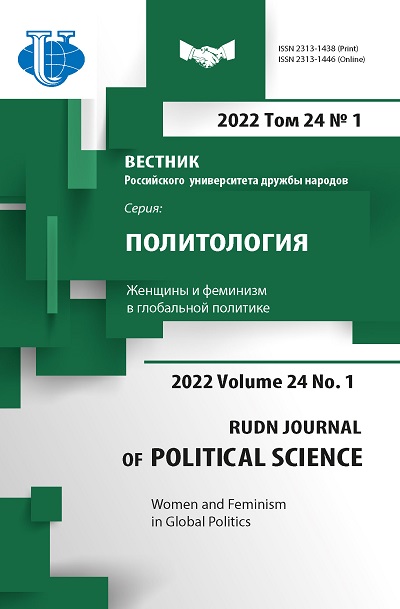Четвертая волна феминизма: политический дискурс и лидеры мнений в социальной сети Твиттер
- Авторы: Гнедаш А.А.1
-
Учреждения:
- Кубанский государственный университет
- Выпуск: Том 24, № 1 (2022): Женщины и феминизм в глобальной политике
- Страницы: 64-89
- Раздел: ФЕМИНИЗМ КАК ИДЕОЛОГИЯ И КОНЦЕПТУАЛЬНОЕ ОСНОВАНИЕ ПОЛИТИКИ
- URL: https://medbiosci.ru/2313-1438/article/view/322591
- DOI: https://doi.org/10.22363/2313-1438-2022-24-1-64-89
- ID: 322591
Цитировать
Полный текст
Аннотация
В XXI веке феминистское движение остается одним из крупнейших общественно-политических движений и обретает новую платформу консолидации - Интернет и новые способы мобилизации - социальные медиа. Освещение деятельности участников(ниц) и сторонников(ниц) движений Women’s Mаrch и #MeToo, актуализация женского вопроса и проблем гендерного равенства в цифровой социально-политической повестке, а также дискурс о ситуации с правами и свободами женщин в Афганистане делает актуальным поиск объяснительных моделей новых феноменов в развитии феминизма. Социальные медиа демократизировали феминизм и создали прецеденты конвертации политического капитала феминисток из онлайн-пространства в офлайн-деятельность (примеры рассматриваются в статье). Для оценки масштаба, содержания и потенциала четвертой волны феминизма в статье приводятся результаты эмпирического анализа Big Data: выгрузки сетевых данных (общее количество составило более 1 000 000 твитов и ретвитов) из социальной сети Twitter по ключевому слову «women». С помощью сетевого, реляционного и лингводискурсивного анализа были проанализированы полученные дата-сеты (в 5 контрольных точках), визуализированы социальные графы, выявлены и описаны лидеры мнений (и цифровой контент, который ими был сформирован) в сформированном политическом дискурсе четвертой волны феминизма в социальной сети Твиттер, определена и охарактеризована динамика ключевых дискурсивных тематик. В результате исследования сделан вывод о том, как проблематика прав афганских женщин вошла в политической дискурс четвертой волны феминизма и как и почему она была замещена проблематикой закона о запрете абортов в штате Техас США. В заключении делается вывод о дальнейших перспективах развития дискурсивного поля четвертой волны феминизма.
Об авторах
Анна Александровна Гнедаш
Кубанский государственный университет
Автор, ответственный за переписку.
Email: anna_gnedash@inbox.ru
ORCID iD: 0000-0002-3516-107X
кандидат политических наук, доцент
Краснодар, Российская ФедерацияСписок литературы
- De Beauvoir, S. (1949). Le Deuxième Sexe. Paris: Gallimard [Beauvoir, de S. (2015). Second sex. Moscow. (In Russian)].
- Bonfiglioli, C. (2020). Women’s activism, the Cold War, and the UN Decade for Women (1975–1985). Aspasia, 14(1), 144–147. https://doi.org/10.3167/asp.2020.140110
- Bryson, V. (1992). Feminist political theory: An introduction. UK: MacMillan [Bryson, V. (2001). The political theory of feminism. Moscow. (In Russian)].
- Burgess, S.K. (2018). Between the desire for law and the law of desire: #MeToo and the cost of telling the truth today. Philosophy & Rhetoric, 51(4), 342–367. https://doi.org/10.5325/philrhet.51.4.0342
- Käppeli, A.-M. (2015). Feminist Scenes. In G. Fraisse & M. Perrot (Eds.), A history of women in the West, Vol. 4. Emerging feminism from revolution to World War. Belknap Press: An Imprint of Harvard University Press [Käppeli, A.-M. (2015). Images of feminism. In History of women in the West. Volume IV: The Rise of Feminism: From the French Revolution to the World War. St. Petersburg. (In Russian)].
- Crawford, E. (2002). The Women’s Suffrage Movement: A Reference Guide 1866–1928. London.
- Diamond, D. (2009). The fourth wave of feminism: psychoanalytic perspectives. Studies in Gender and Sexuality, 10(4), 213–223. https://doi.org/10.1080/15240650903228187
- Felmlee, D.H., Blanford, J.I., Matthews, S.A., & MacEachren, A.M. (2020). The geography of sentiment towards the Women’s March of 2017. PLOS ONE, 15(6), e0233994. https://doi.org/10.1371/journal.pone.0233994
- French Feminist Thought: A Reader. (1987). New York.
- Gnedash, A.A. (2016). Conceptualization of the phenomenon of the fourth wave of feminism in the new political reality. In O.V. Gaman-Golutvina, L.V. Smorgunova & L.N. Timofeeva (Eds.), Russia in the New Political Reality: Strategies and Methods of Development (pp. 75–76). Proceedings of the All-Russian Scientific Conference of the RAPS. Moscow: RANEPA. (In Russian).
- Hall, S. (2010). American Patriotism, American Protest: Social Movements Since the Sixties. Philadelphia.
- Thébaud, F., Duby, G., & Perrot, M. (Eds.) (2000). Toward a cultural identity in the twentieth century (Volume V) (History of women in the West). Belknap Press: An Imprint of Harvard University Press [History of Women in the West. Volume V: The Formation of Cultural Identity in the 20th Century (2015). St. Petersburg. (In Russian)].
- Just, S.N., & Muhr, S.L. (2019). “Together We Rise”: Collaboration and contestation as narrative drivers of the Women’s March. Leadership, 15(2), 245–267. https://doi.org/10.1177/1742715018809497
- LeGates, M. (2001). In Their Time: A History of Feminism in Western Society. NY.
- Looft, R. (2017). #girlgaze: photography, fourth wave feminism, and social media advocacy. Continuum, 31(6), 892–902. https://doi.org/10.1080/10304312.2017.1370539
- Maclaran, P. (2015). Feminism’s fourth wave: a research agenda for marketing and consumer research. Journal of Marketing Management, 31, 1732–1738. https://doi.org/10.1080/0267257X.2015.1076497
- Mendes, K., Ringrose, J., & Keller, J. (2018). #MeToo and the promise and pitfalls of challenging rape culture through digital feminist activism. European Journal of Women’s Studies, 25(2), 236–246. https://doi.org/10.1177/1350506818765318
- Moni, S. (2020). Intersectionality in the contemporary women’s marches: Possibilities for social change. Journal of Feminist Scholarship, 16, 1–16. https://doi.org/10.23860/jfs.2019.16.01
- Orloff, A.S. (2009). Gendering the comparative analysis of welfare states: An unfinished agenda. Sociological Theory, 27(3), 317–343. https://doi.org/10.1111/j.1467-9558.2009.01350.x
- Phillips, R., & Cree, V.E. (2014). What does the ‘fourth wave’ mean for teaching feminism in twenty-first century social work? Social Work Education, 33(7), 930–943. https://doi.org/10.1080/02615479.2014.885007
- Prochaska, F.K. (1980). Women and Philanthropy in 19th Century England. London.
- Ryabchenko, N.A., Katermina, V.V., Gnedash, A.A., & Malysheva, O.P. (2018). Political content of social movements in the online space of modern states: methodology of the analysis and research practices. South-Russian Journal of Social Sciences, 19(3), 139–162. (In Russian).
- Smith-Rosenberg, C. (1971). Religion and the Rise of American City. Ithaca.
- Vickery, A.E. (2018). After the march, what? Rethinking how we teach the feminist movement. Social Studies Research and Practice, 13(3), 402–411. https://doi.org/10.1108/SSRP-05-2018-0020
- Wahyudiputra, A., Amrullah, A.T., & Adrian, D. (2021). The Weinstein Effects: forecasting the genesis of cancel culture in Hollywood industry. Journal of Language Literary and Cultural Studies, 4(1), 39–47. https://doi.org/10.30996/anaphora.v4i1.4710
- Women in German History: From Bourgeois Emansipation to Sexual Liberation. (1989). Oxford.
- Zarkov, D., & Davis, K. (2018). Ambiguities and dilemmas around #MeToo: #ForHow Long and #WhereTo? European Journal of Women’s Studies, 25(1), 3–9. https://doi.org/10.1177/1350506817749436
Дополнительные файлы








